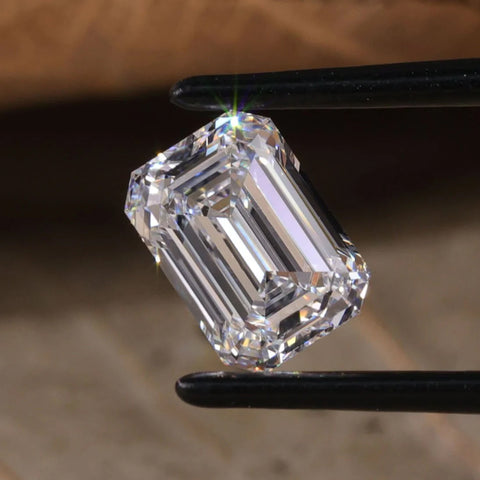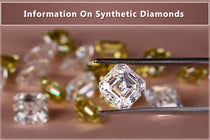There are more opportunities than ever to buy jewelry that is environmentally friendly and sustainable, just like there are for every other item in our wardrobes.
In an effort to leave a more ethical and sustainable legacy, many jewelers choose to use lab grown GIA diamonds rather than their natural counterparts in their designs. It makes sense that many celebrities are choosing lab-grown diamond brands because they have a less negative impact on the environment and place a higher priority on responsibility.
Alternatives produced in laboratories not only benefit the environment but also your wallet. The creation of a diamond in a lab is also more affordable, allowing for lower retail prices for the finished products.
1.13 CT Oval Lab Grown Diamond Engagement Ring, EF/VS Lab Diamond Handmade Ring
All of our efforts to become more conscious consumers will be in vain if we aren't taking proper care of the items we buy, whether they are clothes or jewelry so that they last a lifetime.
Taking good care of your jewelry box is just as important as taking good care of your wardrobe. Make sure to continue to care for your pieces after you've made the purchase, whether that means keeping an eye on them at home or having them cleaned by a professional.
What is the easy way to buy the best lab diamond jewelry?
There are a few things to keep in mind when looking for the best lab diamond jewelry, including:
- Make a budget: Decide how much you are willing to spend on jewelry featuring lab-grown diamonds. Although the cost of lab-grown diamonds is typically lower than that of natural diamonds, prices can still change depending on factors like size, quality, and design.
- Pick a trustworthy jeweler: A reputable jeweler with a focus on lab-grown diamonds should be sought out. Check the jeweller's reputation, read customer reviews, and see if they have any accreditations or connections to trade associations.
One of the top suppliers of diamonds with an ethical origin is Diamondrensu. Our "beyond conflict-free" ethos is appealing to socially conscious customers. We design pieces of exceptional quality and sustainability that fit a range of price points. We use lab grown diamond jewelry that are completely traceable, so you are aware of their origin and method of creation.
The brand is well-known for luxury jewelry with a conscience, offering everything from lovely bracelets to specially made pieces. Color enthusiasts take note. A variety of lab-grown diamonds are available from the Indian jewelry company Diamondrensu in green, yellow, blue, and pink hues. By attempting to use only recycled metals in its creations, the label also lessens the impact it has on the environment.
In order to achieve the same aesthetic as naturally mined diamonds, Diamondrensu, a custom jeweler, uses diamonds that have been grown in a lab. They are a particular favorite of those seeking lovely lab diamond rings that are eco-friendly and sustainable.
The professionals at Diamondrensu, based in India's famous diamond city of Surat, can help you design the ideal lab-grown engagement ring. They offer exquisitely crafted lab diamond rings set with ethical, lab-grown diamonds. Celebrate mindfully as well as with style.
- Think about the 4Cs: The characteristics that determine a diamond's quality and value are known as the 4Cs: carat weight, cut, color, and clarity. Depending on your preferences, be sure to pick a lab-grown diamond that has a good balance of these elements.
- Decide on the type of jewelry: Decide whether you want to purchase a ring, necklace, or a pair of earrings made of lab-grown diamonds. Think about the design elements that will suit your tastes in terms of style, metal type, and other elements.
- Request certificates: Make sure the lab-grown diamond you are purchasing has a certificate from an established grading lab. You can learn more about the diamond's quality, including its 4Cs, measurements, and any additional features, from this certificate.
- Look over the return policy: Prior to purchasing, be sure you are aware of the jeweler's return policy. In the event that you need to exchange or return the item, this may give you peace of mind.
Which type of lab diamond jewelry is available?
As with natural diamonds, a variety of lab-grown diamond jewelry options are available. Here are some popular designs of jewelry made with lab-created diamonds:
- Lab Diamond Rings: Lab created diamond rings are a popular option for engagement rings because they provide a more affordable option without compromising the stone's beauty or durability.
- Earrings: A range of earring designs, including stud, hoop, drop, and chandelier, are available with lab-grown diamonds.
- Necklaces: Lab-grown diamond necklaces are available in a variety of designs, from straightforward solitaire pendants to ornate necklaces covered in diamonds.
- Bracelets: Tennis bracelets, bangle bracelets, and charm bracelets are just a few examples of the types of bracelets in which lab-grown diamonds can be set.
- Wedding Bands: Lab-grown diamonds are a popular option for both men's and women's wedding bands when it comes to wedding bands.
- Pendants: Lab-grown diamond pendants are available in a wide range of sizes and shapes, such as round, oval, pear, and heart. They can be set in a variety of metals, including platinum, white gold, and yellow gold.
- Cufflinks: Men's cufflinks can also be made with lab-grown diamonds. These can be made in a variety of designs, such as straightforward and elegant patterns or more complex and intricate ones.
- Brooches: A timeless piece of jewelry, lab-grown diamond brooches can be worn alone or as a statement piece to accessorize clothing. They can be set in a variety of materials, such as platinum, gold, and silver.
- Anklets: A variety of styles and designs of anklets can be created using lab-grown diamonds. While some only have a single diamond, others have several diamonds arranged in a row or other pattern.
- Hair Accessories: Lab-grown diamonds can be used to create headbands, clips, and other types of hair jewelry. These can be an excellent way to give any hairstyle a dash of class and glitz.
Overall, lab-grown diamonds are an adaptable option for a range of jewelry styles, providing natural diamonds' brilliance and durability while also being more reasonably priced and environmentally friendly.
In which clarity and color grade lab diamond jewelry should the buyer get?
The clarity and color grades of the diamond are two of the most crucial factors to take into account when buying lab diamond engagement rings. These elements can have a significant impact on the diamond's quality and value as well as the cost of the jewelry.
Emerald Cut Lab Created Diamond, 1.01 CT EF/VS Loose Lab Grown Diamond for Engagement Ring
Clarity Grades:
A diamond's clarity is determined by whether it has blemishes and inclusions or not. These can be brought on by flaws both internal and external, like cracks, pits, or other innate qualities. The size, location, quantity, and visibility of these flaws all play a role in determining the clarity grade of a diamond.
The same scale that is used to grade natural diamonds is typically used to grade lab-grown diamonds. There are various grades between Flawless (FL) and Included (I3) on this scale. The diamond is regarded as having fewer flaws and being more valuable the higher the clarity grade.
A clarity grade of VS1 or higher is advised for the most sparkle and brilliance. This indicates that the inclusions in the diamond are very small and difficult to see even with a 10x magnification. However, if money is tight, you might want to consider clarity grades of SI1 or SI2. Depending on the size and placement of the inclusions, these grades can still appear eye-clean to the naked eye and are still reasonably priced.
Color Grades:
The presence or absence of color within a diamond is referred to as the stone's color. A diamond is thought to be more valuable the less color it has. On a scale from D (colorless) to Z (light yellow or brown), with a number of grades in between, diamonds are rated.
For lab-grown diamonds to appear white and bright, a color grade of G or higher is advised. A color grade of H or I, however, can also appear white and provide good value if you have a smaller spending limit.
It's important to remember that a diamond's color can be affected by the setting it is in as well as the lighting it is exposed to. In contrast, a white gold or platinum setting will draw attention to any yellowish tints in the diamond, making a slightly yellow diamond appear more white.
Your personal preferences and financial constraints will ultimately determine the clarity and color grades you select. It's crucial to think about what matters most to you in terms of diamond appearance and weigh that against your spending limit. Working with a reputable jeweler who can walk you through the process and help you find the best value for your money is always a good idea.
When purchasing lab diamond jewelry, there are additional aspects to take into account in addition to clarity and color, such as cut and carat weight. A diamond's proportions and angles, known as its cut, have a significant impact on its brilliance and fire. The size of the diamond, or its carat weight, plays a significant role in determining how much it is worth.
It's important to conduct research before purchasing lab grown diamond engagement rings and to compare the prices and levels of quality offered by various jewelers. Be on the lookout for jewelers who are open about their grading guidelines and who provide warranties or guarantees for their goods. You can find the ideal lab diamond jewelry that suits your preferences and budget with a little research and advice.
Conclusion
Lastly, when purchasing lab diamond jewelry, it is important to carefully consider a number of factors, such as the clarity and color grades, the cut, and the carat weight. It's crucial to strike a balance between quality, price, and personal preferences when it comes to clarity and color grades.










